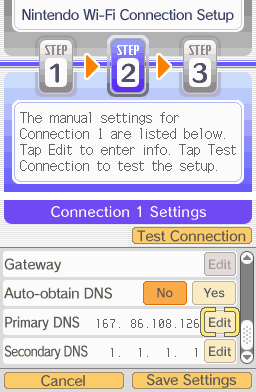Computing » Nintendo DS connectivity
The Nintendo DS was released in 2004, back when Wi-Fi was a relatively new technology, and when WEP (Wired Equivalent Privacy) was the dominant encryption for Wi-Fi connection. Since then, Nintendo Wi-Fi Connection (WFC) has been shut down, and WEP has been obsoleted and removed from most Wi-Fi access points due to a slew of security issues.
This guide aims to connect either an original or emulated Nintendo DS to the modern-day Internet and re-enable online play with fellow DS (and DS emulator) players.
Creating an access point
Terminology: An access point (AP) is a device which allows wireless devices to connect to a wired network (i.e. the Internet). You might be more familiar with wireless routers; these are gateways to the Internet that also function as access points. Access points can broadcast one or more networks, which each have their own separate name, password and so forth. A MAC address is a unique string of numbers and letters which identifies a specific device on a network.
The Nintendo DS is only able to connect to networks with WEP encryption or no encryption. Both of these are considered terrible options for wireless networks nowadays, as the former has compromised, weak security and the latter just has none at all, making it easy for nefarious third parties to intercept and/or spy on your Internet traffic. However, if you’re creating an isolated network for the sole purpose of connecting your Nintendo DS, the risk of someone actually spying on your Wi-Fi transmissions, inferring the encryption key and gaining illicit access to your network is infinitesimally small—and even if they hack in, what sensitive data are you sending using a Nintendo DS?
Method A: Old hardware with WEP
This is the easier of the two methods, as it only requires you get your hands on a wireless router that still has WEP encryption available. Once you’ve done just that, you can connect the new router to your existing router (or to your dormitory’s Ethernet port) and create a WEP-encrypted network for your DS. As the methods to do this will vary wildly with the firmware (baked-in software) on each router, I’ll leave the findings-out to you and Google.
Method B: New hardware with open access & MAC filtering
Most contemporary home router firmware lacks support for WEP, as it’s been considered obsolete since 2005. However, some advanced router firmware, particularly the third-party OpenWrt, allows for MAC address filtering, which allow only certain devices to connect to the network. While MAC addresses are spoofable, as said above, the chance of anyone trying to find a valid MAC address and spoofing it to gain access to your network is negligible.
In order to use this method, you’ll have to find your DS’ MAC address. Once you’ve created a new network (for the same reason as in Method A, it‘s up to you to find out how), whitelist your DS’ MAC address. Do make sure you haven’t created an OWE (Opportunistic Wireless Encryption) network, as this is incompatible with the DS!
Connecting on emulators
If you’re using melonDS—arguably the most popular Nintendo DS emulator—an open network with the SSID melonAP already exists, fully functional on most systems.
Re-enabling Nintendo WFC
Nintendo Wi-Fi Connection—the service which enabled online play for a multitude of DS and Wii games—shut down in 2014. However, enthusiasts have replicated much of WFC’s functionality under the Wiimmfi project, which, on the Nintendo DS, simply requires you set a custom DNS when connecting to your Wi-Fi network. For details on how this works, gloss over the Wiimmfi development log.
When connecting to your network, set the primary DNS to the Wiimmfi server, 167.86.108.126 (up-to-date as of 24 January 2023), and the secondary to 1.1.1.1. In short, any requests sent to Nintendo’s now-nonexistent servers will be redirected to the Wiimmfi servers, and your DS won’t be any the wiser.
